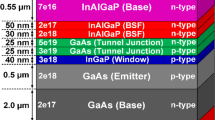Abstract
The operation of hetero In0.49Ga0.51P–Al0.7Ga0.3As tunnel diodes has been evaluated, and an approach for optimizing the back surface field (BSF) layer of a InGaP/GaAs dual-junction (DJ) solar cell developed. The results show that the hetero In0.49Ga0.51P–Al0.7Ga0.3As tunnel diode transferred more electrons and holes and showed less recombination between the top and bottom cells with increased efficiency (η) in the InGaP/GaAs DJ solar cell. To achieve higher open-circuit voltage (Voc), GaAs semiconductor was investigated to match with Al0.52In0.48P with bandgap of 2.4 eV, and replacement of the bottom cell in the InGaP/GaAs DJ solar cell with such an Al0.52In0.48P–GaAs heterojunction increased the photogeneration in this region. In the next step, addition of a BSF layer to the top cell required two BSF layers in the bottom cell to optimize the short-circuit current (Jsc) and η. The thickness and doping of the BSF layers were increased to obtain the highest η for the cell. The proposed structure was then compared with previous works. The proposed structure yielded Voc = 2.46 V, Jsc = 30 mA/cm2, fill factor (FF) = 88.61%, and η = 65.51% under AM1.5 (1 sun) illumination.
Similar content being viewed by others
References
S. Abbasian and R. Sabbaghi-Nadooshan, Optik 136, 487 (2017).
P.P. Nayak, J.P. Dutta, and G.P. Mishra, Eng. Sci. Technol. Int. J. 18, 325 (2015).
B. Galiana, I. ReyStolle, M. Baudrit, I. Garcia, and C. Algora, Semicond. Sci. Technol. 21, 1387 (2006).
A. Mesrane, A. Mahrane, F. Rahmoune, and A. Oulebsir, J. Electron. Mater. 46, 1458 (2017).
J.W. Leem, Y.T. Lee, and J.S. Yu, Opt. Quantum Electron. 41, 605 (2009).
S.M. Sze and M.K. Lee, Semiconductor Devices Physics and Technology (Hoboken: Wiley, 2010), pp. 336–345.
K.J. Singh and S.K. Sarkar, Opt. Quantum Electron. 43, 1 (2011).
D.A. Neamen, Semiconductor Physics and Devices (New York: McGraw-Hill, 2003), pp. 313–316.
P. Michalopoulos, A novel approach for the development and optimization of state-of-the-art photovoltaic devices using Silvaco, naval postgraduate school Monterey, California, (2002).
I. Vurgaftman, J.R. Meyer, and L.R. Rammohan, J. Appl. Phys. 89, 5815 (2001).
A.S. Gudovskikh, K.S. Zelentsov, N.A. Kalyuzhnyy, V.M. Lantratov, and S.A. Mintairov, in 25th European Photovoltaic Solar Energy Conference and Exhibition (2010) pp. 472-476.
T.P. White, N.N. Lal, and K.R. Catchpole, IEEE J. Photovolt. 4, 208 (2014).
G. Streetman and S.K. Banerjee, Solid State Electronic Devices, 6th edn. (2006) pp. 508-512.
SILVACO Data Systems Inc., Silvaco ATLAS User’s Manual, (2010).
H.Y. Lee and C.T. Lee, in Proceedings of the 8th International Conference on Electronic Materials, (2002), pp. 99-102.
G.S. Sahoo, P.P. Nayak, and G.P. Mishra, Superlattices Microstruct. 95, 115 (2016).
M. Dey, M.A. Matin, and N.K. Das, in IEEE International Forum on Strategic Technology (IFOST). (2014), pp. 334-338.
E.M.K.I. Ahamed, S. Bhowmik, M.A. Matin, and N. Amin, in IEEE International Conference on Electrical, Computer and Communication Engineering (ECCE). (2017), pp. 428-432.
S. Benabbas, H. Heriche, Z. Rouabah, and N. Chelali, in IEEE North African Workshop on Dielectic Materials for Photovoltaic Systems (NAWDMPV). (2014), pp. 1-5.
K.J. Singh and S.K. Sarkar, in IEEE International Conference on Energy Efficient Technologies for Sustainability (ICEETS). (2016), pp. 182-186.
R.R. King, N.H. Karam, J.H. Ermer, N. Haddad, P. Colter, T. Isshiki, H. Yoon, H.L. Cotal, D.E. Joslin, D.D. Krut, R. Sudharsanan, K. Edmondson, B.T. Cavicchi, and D.R. Lillington, in IEEE Photovoltaic Specialists Conference. (2000), pp. 998-1001.
M. Steiner, A. Bösch, A. Dilger, F. Dimroth, T. Dörsam, M. Muller, T. Hornung, G. Siefer, M. Wiesenfarth, and A.W. Bett, Prog. Photovolt. Res. Appl. 23, 1323 (2015).
M.J. Keevers, C.F.J. Lau, M.A. Green, I. Thomas, J.B. Lasich, R.R. King, and K.A. Emery, World Conference on Photovoltaic Energy Conversion (WCPEC-6), (2014), pp. 1-2.
M. Steiner, G. Siefer, T. Schmidt, M. Wiesenfarth, F. Dimroth, and A.W. Bett, IEEE J. Photovolt. 6, 1020 (2016).
M.R. Lueck, C.L. Andre, A.J. Pitera, M.L. Lee, E.A. Fitzgerald, and S.A. Ringel, IEEE Electron Device Lett. 27, 142 (2006).
J.P. Dutta, P.P. Nayak, and G.P. Mishra, Optik 127, 4156 (2016).
Author information
Authors and Affiliations
Corresponding author
Rights and permissions
About this article
Cite this article
Abbasian, S., Sabbaghi-Nadooshan, R. Optimum Design of ARC-less InGaP/GaAs DJ Solar Cell with Hetero Tunnel Junction. J. Electron. Mater. 47, 3585–3595 (2018). https://doi.org/10.1007/s11664-018-6203-z
Received:
Accepted:
Published:
Issue Date:
DOI: https://doi.org/10.1007/s11664-018-6203-z




